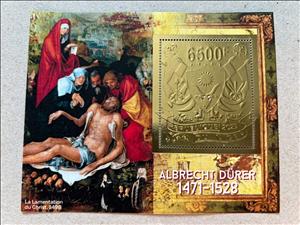Souvenir Sheet: Albrecht Durer Paintings - Foil Coat of Arms (Niger 2023)
Albrecht Durer Paintings - Foil Coat of Arms (Niger 2023)
01 January (Niger ) within release Albrecht Dürer (2023) goes into circulation Souvenir Sheet Albrecht Durer Paintings - Foil Coat of Arms face value 6,500 West African CFA franc
Souvenir Sheet is square format.
This item is produced for or by the counterfeit producer located in Moscow, Russia and distributed by criminal counterfeit stamp dealers located in Eastern Europe mainly in Kazakhstan and Estonia. It was created in 2024-5. The production of these counterfeits with foil stamps is massively being placed by the criminals in the name of several African countries. The counterfeit foil stamp used is placed on numerous versions of different series of backgrounds on different topics ranging from the Olympic games to Chess to famous people to Concorde and so forth. All topics consistently used by the counterfeiter in the past. The stamp itself is offered in varieties of gold foil, silver foil or bronze foil as shown in the second image of item NE 2023-01. Avoid anyone selling these!Also in the issue Albrecht Dürer (2023):
- Souvenir Sheet - Albrecht Durer Paintings - Foil Coat of Arms face value 6,500;
- Souvenir Sheet - Albrecht Durer Paintings - Foil Coat of Arms face value 6,500;
- Souvenir Sheet - Albrecht Durer Paintings - Foil Coat of Arms face value 6,500;
- Souvenir Sheet - Albrecht Durer Paintings - Foil Coat of Arms face value 6,500;
- Souvenir Sheet - Albrecht Durer Paintings - Foil Coat of Arms face value 6,500;
Souvenir Sheet Albrecht Durer Paintings - Foil Coat of Arms it reflects the thematic directions:
A coat of arms is an heraldic visual design on an escutcheon (i.e. shield), surcoat, or tabard. The coat of arms on an escutcheon forms the central element of the full heraldic achievement which in its whole consists of shield, supporters, crest, and motto. A coat of arms is traditionally unique to an individual person, family (except in the United Kingdom), state, organisation or corporation.
Famous People refers to the fame and public attention accorded by the mass media to individuals or groups or, occasionally, animals, but is usually applied to the persons or groups of people (celebrity couples, families, etc.) themselves who receive such a status of fame and attention. Celebrity status is often associated with wealth (commonly referred to as fame and fortune), while fame often provides opportunities to make money.
Painting is a visual art, which is characterized by the practice of applying paint, pigment, color or other medium to a solid surface The medium is commonly applied to the base with a brush, but other implements, such as knives, sponges, and airbrushes, may be used. One who produces paintings is called a painter.
Painting is the practice of applying paint, pigment, color or other medium to a solid surface (support base). The medium is commonly applied to the base with a brush, but other implements, such as knives, sponges, and airbrushes, can be used. Painting is a mode of creative expression, and the forms are numerous. Drawing, gesture (as in gestural painting), composition, narration (as in narrative art), or abstraction (as in abstract art), among other aesthetic modes, may serve to manifest the expressive and conceptual intention of the practitioner. Paintings can be naturalistic and representational (as in a still life or landscape painting), photographic, abstract, narrative, symbolistic (as in Symbolist art), emotive (as in Expressionism), or political in nature (as in Artivism). A portion of the history of painting in both Eastern and Western art is dominated by spiritual motifs and ideas. Examples of this kind of painting range from artwork depicting mythological figures on pottery, to Biblical scenes rendered on the interior walls and ceiling of the Sistine Chapel, to scenes from the life of Buddha or other images of Eastern religious origin. In art, the term painting describes both the act and the result of the action. The support for paintings includes such surfaces as walls, paper, canvas, wood, glass, lacquer, clay, leaf, copper and concrete, and the painting may incorporate multiple other materials including sand, clay, paper, plaster, gold leaf, as well as objects. The term painting is also used outside of art as a common trade among craftsmen and builders.




